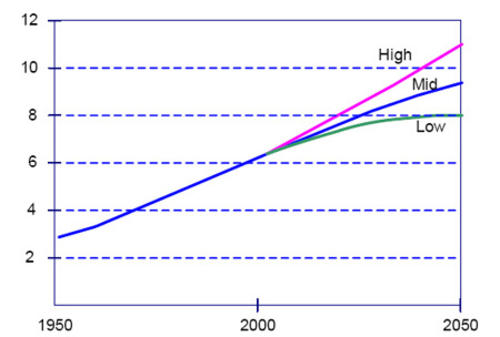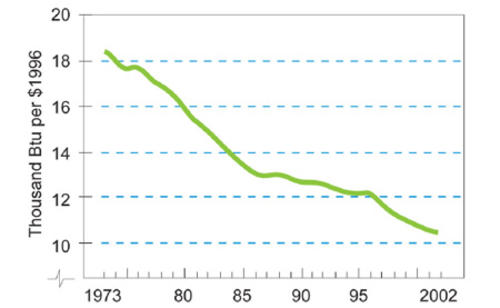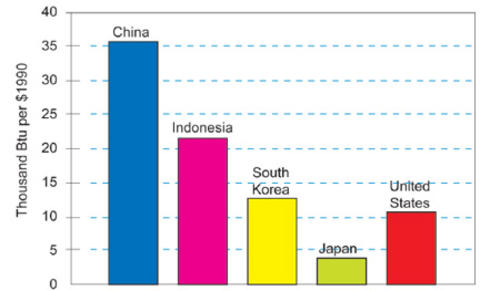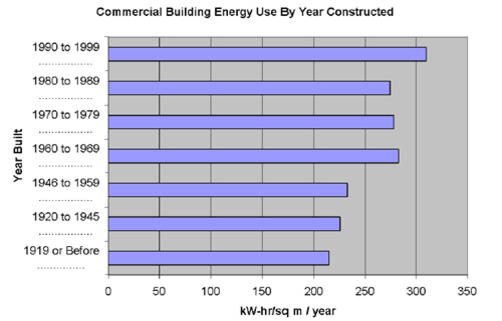The construction and operation of buildings consumes over a third of the world’s energy consumption, and 40% of all the mined resources. Striving to make buildings more sustainable, while saving construction and operating costs and improving health and occupant well being is not only possible and practical, it should be the goal of the building industry. Achieving this goal requires an awareness of the problem and the skills to design, specify, construct, and operate buildings in a manner that is often quite different from current standard approaches. This digest will review the challenge of sustainability, discuss methods of assessing green buildings, and recommend a process by which more sustainable buildings can be delivered.
Background on Sustainability
The environmental challenge we face can be summarized as dealing with an increasing population with increasing consumption per person and increasing damage per action. This can be placed in the context of an equation as:
Environmental impact = population x consumption/person x damage rate/ unit consumption
The world’s population continues to grow, and grow fastest in the developing world. The population has more than doubled in the last forty years to over 6 billion people. The good news is that the rate of population increase is projected to decrease, and if we continue efforts on population control, we may be able to keep the peak population (which will be reached around 2050) of the world under 9 billion (Figure 1).
Figure 1: World Population Projections (UN Population Division)
The fact that much of the future population growth will be in the developing world is relevant because the standard of living (and the rate of energy and resource consumption per person) is increasing quickly in these countries. Hence, we will not only have 3 billion more people on the planet in 50 years, but most of these people will wish to consume considerably more resources per capita than they do presently. This trend is particularly evident in the two largest countries, China and India (who together comprise more than 1/3 of the world population).
At the same time as the developing world is growing rapidly, many of the buildings constructed in the developed world in the last 30 to 50 years have a shorter useful service life than older buildings. For example, although a turn of the century solid brick home is still functional today, it is unlikely that a home built in the 1980’s will be sufficiently functional to still be in service in 2080. This means that many of the buildings that already exist in developed countries will need to be extensively rebuilt or replaced at the same time as many new buildings will be required in the developing world.
Another major trend is where people live. Whereas 30 per cent of the world population lived in urban areas in 1950, the proportion of urban dwellers rose to 47 per cent in 2000 and is projected to attain 60 per cent by 2030 according to a recent UN report. This increasing urbanization changes the types of solutions that will be required to allow us to build and live sustainably.
The environmental damage (i.e., ecosystem destruction, species extinction, and pollution) caused by our consumption is significant. Some consumption causes more damage than other types. For example, traveling to work with a large sport utility vehicle or pickup truck consumes more energy and emits more pollution than the equivalent trip by subway. The consumption levels of the Western world increased with our “progress” (e.g., we drive further to work and play than ever before), and the development path taken by developing countries is typically following the same path, i.e., more damage for many of the same activities (e.g., as Indians and Chinese become wealthier, cars are chosen for the same journey that would previously have been conducted by walking or taking public transit). The fact that 33% of the world population growth over the next 50 years will be in the emerging economies of China and India underscores the scale of this potential phenomenon.
If developing countries even come close to the developed world’s rates of energy and resource use on a per capita basis, the consumption and damage will increase much more quickly than the population, and environmental damage can be expected to increase five or ten fold above current levels. This level of resource consumption and environmental damage cannot be tolerated: either populations will be reduced by disease, drought and starvation or per capita consumption and damage must be reduced.
The hope for the future is that if the industrialized world will reduce its consumption and its impact so that it demonstrates to the remaining three quarters (or more) of the world’s people how to avoid an environmental catastrophe.
The developed world, and North America in particular, is unfortunately not reducing its per capita energy or resource use. Despite much more knowledge and incredibly powerful technology, our buildings’ energy consumption continues to grow with time. For example, consider Figure 2, a plot of the actual measured energy use of thousands of commercial buildings across the United States in the year 2000 (from the Energy Information Agency). The buildings that use the least energy are the oldest buildings, and a clear trend can be seen toward higher energy consumption for new buildings. Knowledge and technology is obviously not sufficient to provide a solution. The use of energy per capita in the United States has been constant since about 1970. However, the good news is that the energy use per unit GDP in the United States has been dropping. Other developed countries (such as Japan and Germany) have shown that the energy density can be much lower, but developing countries such as China and Indonesia need to become much more efficient.
Figure 2: American Energy Intensity per Unit GDP since 1973 (Source Economist, EIA)
Figure 3: 2001 Energy Intensity per Unit GDP (Source EIA)
The result of continued high levels of fossil fuel energy use creates pollution and carbon emissions that contribute to accelerating climate change. Current levels of resource extraction and environmental damage are beginning to hinder our ability to grow food and reduce quality of life. The awareness of these problems is growing.
Buildings operations consume more than 2/3 of all electricity and about 40% of all resources.
The solutions, like the problems, are complex and multi-disciplinary. Building professionals have a unique potential to make a significant contribution to the solutions, since they are the best prepared to deal with this complex socio-techno-economic problem. Better technology will help, but more will be achieved by changing the way we work, design, travel, build, and live.
Figure 4: Year 2000 Energy Consumption of Commercial US Buildings as a Function of Year Built
Solutions: Sustainable Building and Green Building
The terms “sustainable”, “green” and the like have become a part of many discussions, product advertisements, and everyday speech. However despite the growing pervasiveness of such terms, it is remarkable how imprecise and poorly understood the concept of sustainability is. It is also not widely appreciated how difficult it will be to move toward a sustainable society or how significant the required changes will be.
The United Nations Bruntland Commission Report is the source and inspiration for the popularization of the concept of sustainability. The definition of sustainable development given was:
“Sustainable development is development which meets the needs of the present without compromising the ability of future generations to meet their own needs.”
A more correct and rigorous definition can be found in most chemistry, biology, and even economics textbooks:
A sustainable society, process, or product is one that can be sustained or continue to be produced over the long term, without adversely affecting the conditions necessary to support those same activities in the future.
When applied to human impact on the environment, the conditions referred to above are the natural systems (e.g., soil, ecosystem, water, plants, etc) that provide all of our material and energy resources including clean air, water, food, etc. Applying this definition to that of a building:
A sustainable building is one that can be produced and continue to be operated over the long term without adversely affecting the natural environment necessary to support human activities in the future.
In more practical terms, this means that a sustainable building cannot, in construction, operation, or disposal:
- consume materials unless they can be easily and harmlessly extracted, used, and returned to nature,
- consume non-renewable energy,
- destroy natural habitat, bio-diversity, or bio-mass, or
- release pollutants of a type or quantity that cannot be harmlessly broken down by natural systems.
These are very difficult criteria to meet, and in fact require all aspects of human activity to be changed to meet them. For example, until steel is recycled in a non-polluting manner using renewable energy sources, no steel of any type (including nails or screws) can be included in a truly sustainable building. Clearly we are very far from producing even a single truly sustainable building in the industrialized world. However, to move toward these goals is both possible and practical.
Given how far we are from producing truly sustainable buildings, a working definition of a green building is one that is more sustainable than current practise. The operative goals of a green building can be stated as:
A green building is one that uses energy and material more effectively both in production and operation while polluting and damaging natural systems as little as possible.
A reasonable measure of a green building might be one that is significantly better than similar, or average, buildings of the same size and type in the same area. Hence the question to ask of anyone claiming to have created a green building is by comparison to other buildings:
- Does it use less non-renewable energy to operate?
- Did it use fewer resources to build?
- Will it last as long as it can be used without undue effort to extend its life?
- Does it produce less pollution and damage natural systems less?
In a remarkable number of so-called green buildings, the answer to few of these questions is yes. The comparison should be to the average building, NOT to a code number (such as ASHRAE 90.1) or a design posed by the design team. These comparisons are not valid as in the former case; they will only result in buildings getting close to the code (a politically chosen target) not to sustainability. In the latter case, a design that is better than a bad design is not necessarily a green design. In commercial architecture, it is common for claims of “30% less energy” to be heard, as the original design was very poor. Real, absolute energy and resource use numbers should be given for useful comparisons, such as “30% less energy is used per square foot than the average of all other office buildings in the state." This type of definition means that green buildings will be a moving target that slowly slides toward a sustainable one over time, and encourages constant improvement.
If one accepts the definition of building science as “the science and art of producing and operating buildings”, then there is clearly a very large overlap between the skills and interests of a green builder/designer and those of a building scientist. Hence, “green” buildings are simply good buildings in most ways. That is, they are:
- Energy efficient – in operation and in construction
- Resource efficient – in operation and in construction
- Non-polluting – in operation and production
- Durable – so that they can be used for a long time
- Adaptable for many uses – so they can be re-used easily
- Healthy – few chemicals given off, no mould, fresh air
- Beautiful and comfortable – so that people will want to use and re-use them
Green Building Assessment Tools
Sustainable building ratings systems like LEED, BREAM, etc. use different methods, with unique advantages and disadvantages, to rate environmentally sound buildings.
Regardless of the system used, several aspects of green buildings must be considered:
Site choice and modifications affect the energy and resources required to construct the building (e.g. the less intervention the less resource use and habitat destruction). The type of site and the way in which the architect changes the site will have a profound effect on the local ecology, water run-off, building energy use and durability (by shading wind, sun and rain), etc. In cases where a building is being re-built or renovated, adding plants and animals may be a part of the strategy. Hence, a sustainable building design must include the site.
Transportation Planning is an important part of any building design, since transportation consumes as much energy (and creates more pollution) than the energy used in the building sector. Designing buildings that minimize the need for transportation and encourage the use of less polluting transportation modes (walking, biking, public transit, rail or ship vs. truck, etc. can have a large environmental impact. The addition of day care and a shop for daily needs in an office building can, for example, help reduce the need for additional travel. The most important intervention in this aspect is better planning—higher density towns and cities are critical to a sustainable future.
Resource Efficiency of non-renewable energy and materials. This includes water of course. Renewable energy and materials are the ideal goal, but one must be careful not to violate other principles. Requiring too many resources (e.g., requiring a huge amount of wood to do the job of a small steel column), or too much energy (e.g., adobe may be renewable, but it requires so much energy to heat an adobe building in a very cold climate that it may not make sense), or by generating energy with damaging systems (e.g., photovoltaics generate a significant amount of pollution and consume a lot of energy in production and transportation).
The energy consumed during the construction and operation of buildings forms a major share of total human energy consumption – if one includes community planning in the category of “building”, then buildings consume 50-60% of all energy, with transportation around 25-30%, and industry about 20-25%. Hence, energy consumption must be given serious consideration.
Recycled non-renewable materials, while often an excellent means of reducing resource use, may in some cases use more energy than a different non-recycled virgin material. The obvious example is steel, which is both plentiful and easily recyclable, but consumes so much energy in production and recycling that it is difficult to justify the claims that it is a “green” material. Of course, an attempt to quantify materials as green is fraught with difficulty. Steel is a low-impact way to form roof decking in commercial construction. Open-web steel joists are often the most efficient way to span large distances, although wood and concrete certainly have their place.
The best way to assess resource efficiency is to count—the amount of materials, the amount of Joules, including all transportation impacts. Resources like ATHENA are available to make this type of assessment more manageable.
For some reason, health and indoor environment are often confused with sustainable buildings. While it is clear that healthy buildings will likely survive and be used for a long time, there is little other connection to sustainability. This author would suggest that all buildings, sustainable or not, should be healthy for the occupants. Perhaps the connection is that buildings that are healthy for the community, for the ecology, for people in other countries, as well as for the occupants are sustainable.
These attributes require one to consider more aspects in the design of a building than normally done.
Material Life-cycle: a cradle to grave view of all materials, from resource extraction to material disposal/reuse including pollution created. The complexity of some materials and their life cycle is so high that this is often reason enough to avoid them.
Building Life-cycle: Which requires a flexible/adaptable design to allows for possibilities for re-use of building for different functions, re-arrangement of building, change in energy sources, replaceable and repairable components, sustainable lifestyles, etc
Good Building Science: which means assembling building materials and systems in such a way that the enclosures controls heat, air and moisture so that a durable, energy efficient building is provided (even if made of, for example, natural materials that may have lower performance than substitutes) without using an excess of materials.
The Process
Changing the process we use to design, construct and operate buildings is not only the most effective means of achieving more sustainable built environment, it is necessary to hit our targets. Technology will assist in this, but is a useless tool unless applied properly by designers, builders, and occupants.
Although many improved processes can be discussed, the following addresses what I believe to be some of the most important points: pet strategies instead of well-defined goals, irrational belief in a strategy instead of rational accounting of energy and resources, and assumptions that a particular design works rather than assessing successes and learning from failures.
1. Decide on Shared Goals
Declaring a goal of “creating a green building” is practically useless for achieving the same. Designers and clients (and ideally the community) should define specific shared goals or values that they wish to achieve in the building design and common definitions for the project (e.g., define “local” in the goal “use local materials”). This may include low operational non-renewable energy use, little ecological damage (or an increase in ecological diversity), or low pollution emissions, or very low non-renewable resource use, or local resource and energy use, etc. Generally, a whole range of goals can be defined and then ranked in priority through group sessions.
2. Choose Strategies
Given the design goals, a range of strategies can be chosen. For example, it is at this stage that photovoltaics (PV), wind power or co-generation can be discussed as strategies to meet the goal of energy self-sufficiency. Too often, designers choose a strategy and force the design goals to fit to the need for PV or green roofs, or rain water collection. Consider not only one strategy or competing strategies but combinations of strategies in your scenarios. For example, the combination of PV and wind power as electrical generation can often make sense in northern climates, since windspeed is high in winter and solar radiation is high in summer.
The most difficult part of choosing strategies is recognizing the synergies for a holistic or systems approach to building design. Component-based cost-benefit analysis often ignores the building system benefits and savings. For example, the cost of a 5 kW solar-electric system is high (e.g., $50,000) and hence is often discarded as an option, but if the use of fewer energy efficient appliances and daylighting are applied to dramatically reduce electricity demand to 2 kW, the much lower cost ($20,000) of the smaller system needed to meet demand may make now sense. (That is, if gasoline costs $4 per gallon, it costs no more to drive 100 miles in a car that gets 40 mpg than it does for a 20 mpg car to drive the same distance with $2/gallon fuel.) In a similar vein, highly insulating windows are often rejected based on first cost, but if the cost savings reaped by smaller air-conditioning system, boiler, fans, and duct sizes are considered, a building can often cost less to build and use less energy to operate while simultaneously improving comfort.
3. Develop Metrics
Given the goals originally set, measures of performance should be set. Good measures include total embodied energy (in GJ/m2), annual purchased energy use (in GJ/m2), total tons of CO2 produced (or preferably absorbed), etc. The most difficult goals to measure are pollution production in construction (since many materials and workers come from far way) and ecological impact. Nevertheless, setting goals without measurable targets has far less impact than no targets at all.
4. Measure Performance
If you can’t measure it, you can’t control it. It may be energy, resource use, or pollution. To assess strategies, the performance of various scenarios must be assessed. This often requires computer energy-use models, daylighting models, and other such tools. However, the most useful tool that a green architect can use is a simple spreadsheet program that accounts the amount of materials used, the total energy use of a building (for lighting, plug loads, air leakage, conduction).
It is critical that the resources consumed during construction be accounted for. The choice between linoleum and VAT flooring material can be debated, but the use of half as much of either is always preferred. Assessing the need for square footage is the largest source of savings. A 2100 s.f. house is always superior to an equivalent 4000 s.f. house. Additional and potentially unnecessary finishes (like linoleum over concrete, when stain and sealer may be enough), high embodied energy or distantly sourced materials (like chromed interior metal or Italian marble) can easily be seen as less sustainable when the other choices are simply compared in a list.
Performance measurement should be used iteratively during the design phase. One must find architects, and energy and structural engineers that can iteratively assess multiple concept designs so that the optimal solution can be achieved. Developing a design that is then handed to an engineer for tweaking will not result in optimal buildings (although this is the most common process today). Energy and material use must be considered often, early, and quantitatively in the design process.
Finally, the resulting building should be monitored, an audit of how much construction waste was generated, how many cubic meters of concrete consumed, and how much energy it actually requires to operate must be measured and documented if a building is to be declared sustainable.
Summary
The challenge of making the transition to a sustainable society is complex problem. Buildings and the built environmental are a very large part of the problem and are likely to increase in importance given global trends in population and economic development. This digest has outlined the context for sustainable building and has attempted to provide clear definitions and practical goals for sustainable building and green building.
Green buildings require designers and builders to understand the problem, modify their processes, and predict/measure the outcomes against some standard. Only in this way can we improve our current buildings, building new green buildings, and head towards a sustainable future.




